|
Accurately tracking the HIV epidemic is essential
to the nation’s HIV prevention efforts. Yet monitoring trends in new HIV infections has historically posed a major challenge, in part because many HIV infections are not diagnosed until years after they occur.
Now, new technology developed by the Centers for Disease Control and Prevention (CDC) can be used to distinguish recent from long-standing HIV infections. CDC has applied this advanced technology to develop the first national surveillance system of its kind that is based on direct measurement of new HIV infections. This new system represents a major advance in HIV surveillance and allows for more precise estimates of HIV incidence (the annual number of new infections) than ever before possible.
CDC’s first estimates from this system reveal that the HIV epidemic is—and has been—worse than previously known. Results indicate that approximately 56,300 new HIV infections occurred in the United States in 2006 (95% CI: 48,200–64,500). This figure is roughly 40% higher than CDC’s former estimate of 40,000 infections per year, which was based on limited data and less precise methods (see
“Historical Challenges in Tracking HIV Infections”).
It is important to note that the new estimate does not represent an actual increase in the annual number of new HIV infections. In fact, CDC’s analysis suggests that the epidemic has been roughly stable since the late 1990s, though the number of new HIV infections remains unacceptably high. These findings underscore the ongoing challenges in confronting this disease and the urgent need to expand access to effective HIV prevention programs.
Breakthrough Technology Allows Clearest Picture to Date
CDC’s new HIV surveillance system is based on an approach known as STARHS (serologic testing algorithm for recent HIV seroconversion), which uses innovative testing technology to determine, at the population level, which positive HIV test results indicate new HIV infections (those that occurred within approximately the past 5 months). Before the widespread availability of this technology, HIV diagnosis data provided the best indication of recent trends in key populations. However, diagnosis data indicate when HIV infection is diagnosed, not when a person becomes infected (infection can occur many years before a diagnosis).
Definitions
HIV incidence: The number of people who become newly infected with HIV in a given period.
HIV diagnoses: The number of HIV diagnoses during a given period, regardless of when the persons became infected.
AIDS diagnoses: The number of AIDS diagnoses during a given period. AIDS is diagnosed when an HIV-infected person’s immune system becomes severely compromised (measured by CD4 cell count) and/or the person becomes ill with an opportunistic infection. In the absence of treatment, AIDS usually develops 8 to 10 years after initial HIV infection. With early HIV diagnosis and treatment, an AIDS diagnosis may be delayed by many years. |
By applying this technology to new HIV diagnoses
in 22 states with name-based HIV reporting systems, CDC was able—for the first time—to identify the diagnoses in a given year that represented new infections. By the use of a complex statistical model, these data were extrapolated to the general population to provide the first national estimate of HIV incidence based on direct measurement.
CDC researchers also used a separate method called extended back-calculation to confirm the official 2006 STARHS estimate and to examine historical trends in HIV infections in the United States from 1977 through 2006. The method uses a statistical model that considers all HIV and AIDS cases diagnosed in the United States through 2006 and reported to CDC through June 2007, as well as HIV testing patterns. Extended back-calculation has become possible in the United States because of an expanded name-based HIV reporting system, which provides a population-based system for identifying new diagnoses. However, the method is an indirect measure of incidence and is most reliable for earlier years; data for the most recent years (2003–2006) must be interpreted with caution. Additionally, extended back-calculation does not generate single-year estimates; instead it provides averages for multiyear periods.
The statistical methods used to develop the 2006 incidence estimate and the extended back-calculation historical trends were developed in consultation with outside experts, and both the methods and their application underwent rigorous external
scientific review.
In the future, the STARHS-based surveillance system will provide the most reliable way to monitor incidence trends. The picture will become even clearer as analyses for specific populations are completed (e.g., black women, young men who have sex with men). Now that this system is in place, CDC will be able to provide an updated estimate of HIV incidence in the United States on an annual basis. Trend information from this system will allow for improved targeting and evaluation of prevention efforts for the populations at greatest risk.
The New Estimates
U.S. HIV Epidemic Worse Than
Previously Known
According to the new surveillance system, approximately 56,300 new
HIV infections occurred in the United States in 2006. This number is
approximately 40% higher than CDC’s previous estimate of 40,000 new
infections per year, which was based on less precise methods (see “Historical Challenges in Tracking HIV Infections”).
The new estimate does not reflect an increase in HIV incidence. In fact, CDC’s separate analysis of historical trends indicates that the annual number of new HIV infections has been roughly stable since the late 1990s (Figure 1). CDC’s trend analysis provides a clearer picture of how the nation’s epidemic evolved to its current point. The analysis shows that new infections peaked in the mid-1980s at approximately 130,000 infections per year and reached a low of about 50,000 in the early 1990s. Incidence then appears to have increased in the late1990s but has stabilized since that time (estimates for the three most recent periods analyzed range from 55,000 to 58,500).
Figure 1. Estimated Number of New HIV Infections, Extended Back-Calculation Model, 1977–2006
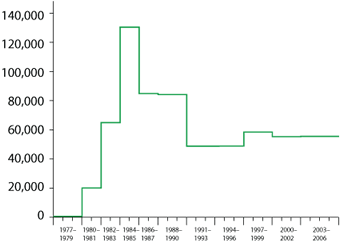
Note: Estimates are for 2-year intervals during 1980–1987, 3-year intervals during 1977–1979 and 1988 –2002, and a 4-year interval for 2003–2006.
Data Confirm Most Severe Impact Is Among Gay and Bisexual Men of All Races and Black Men
and Women
Gay and bisexual men—referred to in CDC surveillance systems as men who have sex with men (MSM)1 —accounted for a significantly greater proportion of estimated new infections in 2006 than any other risk group (Figures 2 and
3). These findings underscore the need to expand access to HIV testing and other proven interventions, and to continue research to identify new interventions to address the evolving needs of diverse populations of gay and bisexual men in the United States. Many factors probably contribute to high risk of HIV among MSM, including the challenge of maintaining safer-sex behaviors, the assumption that one is HIV-negative, underestimates of personal risk factors, and stigma, which may prevent access to needed services and may lead to substance abuse and depression.
Figure 2. Estimated Number of New HIV Infections, Extended Back-Calculation Model, by Transmission Category, 1977– 2006
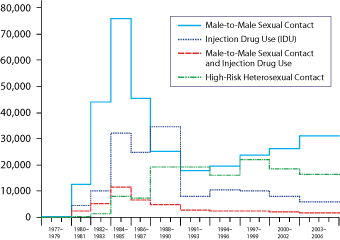
Note: Estimates are for 2-year intervals during 1980–1987, 3-year intervals during 1977–1979 and 1988 –2002, and a 4-year interval for 2003–2006. High-risk heterosexual contact refers to contact with a person known to have, or to be at high risk for, HIV infection.
Analysis by Transmission Category
Male-to-male sexual contact accounted for 53% (28,700) of estimated new HIV infections in 2006. CDC’s historical trend analysis indicates that HIV incidence has been increasing steadily among gay and bisexual men since the early 1990s, confirming a trend suggested by other data showing increases in risk behavior, sexually transmitted diseases (STDs), and HIV diagnoses in this population.
High-risk heterosexual contact2 accounted for 31% (16,800) of estimated new HIV infections in 2006. The historical analysis suggests that the number of new infections in this population fluctuated somewhat throughout the 1990s and has declined in recent years.
Injection drug use (IDU) accounted for 12% (6,600) of estimated new HIV infections. CDC’s historical trend analysis indicates that new infections have declined dramatically in this population; between 1988-90 and 2003-06, HIV infections among injection drug users declined 80%. These declines confirm the success in reducing HIV infections among injection drug users.
Figure 3. Estimated Number of New HIV Infections, by Transmission Category, 2006
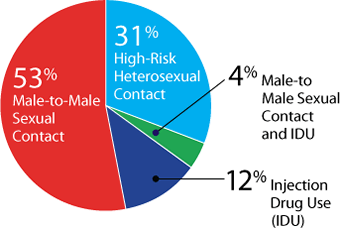
Analysis by Race/Ethnicity
Impact of HIV Greater Among Blacks Than Any Other Racial or Ethnic Group
CDC’s new estimates confirm that blacks are more severely and disproportionately affected by HIV than any other racial/ethnic group in the United States (Figure 4). Trend analyses show that HIV incidence among blacks has been roughly stable at an unacceptably high level since the early 1990s (except for a brief fluctuation in the late 1990s) (Figure 5). The continued severity of the epidemic among blacks underscores the need to sustain and accelerate prevention efforts in this population. Although race itself is not a risk factor for HIV infection, a range of issues contribute to the disproportionate HIV risk for blacks in the United States, including poverty, stigma, higher rates of other STDs, and drug use.
Figure 4. Estimated Rates of New HIV Infections, by Race/Ethnicity, 2006
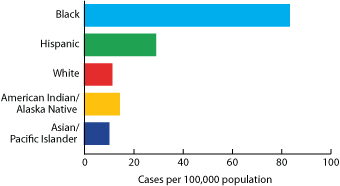
Blacks—In 2006, the rate of new infections among non-Hispanic blacks was 7 times the rate among whites (83.7 versus 11.5 new infections per 100,000 population). Blacks also accounted for the largest share of new infections (45%, or 24,900). Historical trend data show that the number of new infections among blacks peaked in the late 1980s and has exceeded the number of infections in whites since that time.
Hispanics—The rate of new HIV infections among Hispanics in 2006 was 3 times the rate among whites (29.3 versus 11.5 per 100,000), and Hispanics accounted for 17% of new infections (9,700). Historically, the number of new infections among Hispanics has been lower than the numbers among whites and blacks. Incidence trends among Hispanics over time have mirrored those among blacks.
Whites—Whites accounted for 35% (19,600) of estimated new HIV infections in 2006. After declining significantly in the late 1980s, new infections among whites increased slightly during the 1990s and remained stable from 2000 through 2006.
Asians/Pacific Islanders and American Indians/Alaska Natives—Data suggest that Asians/Pacific Islanders accounted for roughly 2% of new infections, and American Indians/Alaska Natives accounted for roughly 1% of new infections in 2006. The relatively small number of infections in these populations makes it difficult to draw reliable conclusions about trends over time in
these populations.
Figure 5. Estimated Number of New HIV Infections, Extended Back-Calculation Model, by Race/Ethnicity, 1977–2006
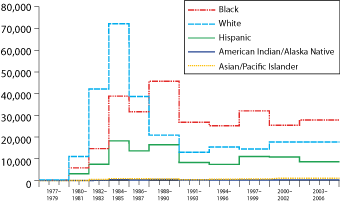
Note: Estimates are for 2-year intervals during 1980–1987, 3-year intervals during 1977–1979 and 1988 –2002, and a 4-year interval for 2003–2006.
Analysis by Gender and Age Group
Gender
Men accounted for most of the estimated new HIV infections in the United States in 2006 (73%, or 41,400) (Figure 6). CDC’s historical analysis indicates that the number of infections among men has mirrored the overall trend in HIV incidence, peaking during 1984–85 and reaching a low point in the early 1990s (Figure 7). Among women, incidence rose gradually until the late 1980s, declined during the early 1990s, and remained relatively stable after that time.
Figure 6. Estimated Number of New HIV Infections, Overall and by Gender, 2006
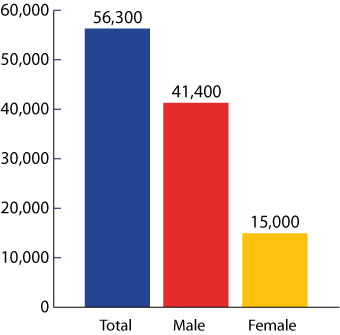
Note: Because of rounding, estimates of subgroups do not add to total.
Figure 7. Estimated Number of New HIV Infections, Extended Back-Calculation Model, Overall and by Gender, 1977–2006
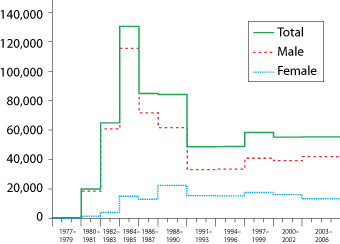
Note: Estimates are for 2-year intervals during 1980–1987, 3-year intervals during 1977–1979 and 1988 –2002, and a 4-year interval for 2003–2006.
Age Group
More infections occurred among young people under 30 (aged 13–29) than any other age group (34%, or 19,200), (Figure 8), followed by persons 30–39 (31% or 17,400). These data confirm that HIV is an epidemic primarily of young people and underscores the critical need to reach each new generation of young people with HIV prevention services. Persons over age 50 continue to account for a relatively small proportion of new infections.
Figure 8. Estimated New HIV Infections, by Age, 2006
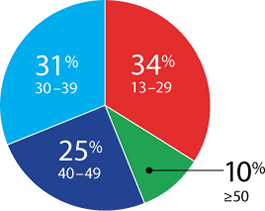
Historical Challenges in
Tracking HIV Incidence
Tracking HIV incidence has been a long-standing challenge in the United States and around the world. Historically, researchers relied on indirect methods to estimate the number of new infections. In the early 1990s, for example, data on U.S. AIDS diagnoses could be used to estimate the number of new HIV infections over time, because the period from initial HIV infection to the development of AIDS was well documented (i.e., about 8 –10 years). However, following the advent of highly active antiretroviral therapy (HAART) in the mid-1990s, the period between HIV infection and AIDS was no longer predictable, and AIDS cases could no longer be used as the primary basis for estimating HIV incidence.
Since that time, it has been necessary to rely on extrapolation from small studies of HIV infections among high-risk populations to estimate HIV incidence for the nation. On the basis of these limited data, CDC estimated that at least 40,000 U.S. residents were infected annually from the early 1990s through 2006. However, because these data were so limited, they were not robust enough to give a precise picture of HIV incidence or to detect changes in incidence over time. |
Implications of the New Estimates
Although the new incidence estimates illustrate the challenges of fighting HIV, there is significant evidence that prevention can—and does—work when we apply what we know.
Stability in the number of new HIV infections since 2000 is an important sign of progress. As the number of people living with HIV increases, there are more opportunities for transmission. Yet HIV transmission has not increased, which indicates that people are taking steps to protect themselves and their partners. The relatively stable number of new infections suggests that the efforts in recent years to provide effective prevention services to people living with HIV/AIDS are beneficial. In addition, the historical trends analysis shows encouraging signs of progress in reducing the number of new infections among injection drug users and heterosexuals.
Nonetheless, rates of HIV infection in the United States are unacceptably high, and far too many persons at risk are not yet being reached. For example, a CDC study of gay and bisexual men in 15 cities found that 80% had not been reached by the intensive HIV prevention interventions that are known to be most effective. And the high rates of infection among young people highlight the urgent need to reach a new generation with
prevention services.
CDC estimates that one-quarter of HIV-infected people are unaware of their HIV infection and that these persons account for more than half of all new infections. To help ensure that all persons know their HIV serostatus, CDC recommends that everyone in the United States aged 13–64—regardless of perceived risk—get tested for HIV to help stop the spread of this disease. In addition, CDC recommends that sexually active gay and bisexual men be tested for HIV at least once a year.
Accelerating progress in HIV prevention will require a collective response that matches the severity of the epidemic. There is an urgent national need to reach all populations at risk with effective prevention programs.
To help prevent new HIV infections among MSM, CDC provides resources to state and local health departments and community-based organizations to help them reach MSM with effective testing and prevention services. Additionally, CDC is working to increase the use of successful prevention interventions for MSM across the country; adapting proven interventions for new populations of MSM, especially MSM of color; and continuing research to understand both the barriers to, and the opportunities for, more effectively reaching this population.
CDC is working to fight HIV among African Americans through the Heightened National Response, a partnership of CDC, public health partners, and African American community leaders to intensify prevention efforts nationwide. The partnership is designed to build upon progress in four key areas: expanding prevention services, increasing testing, developing new interventions, and mobilizing broader community action.
References:
- Hall HI, Song R, Rhodes P, et al.
Estimation of HIV Incidence in the
United States
 .
JAMA. 2008;300:520–529. .
JAMA. 2008;300:520–529.
1The term
men who have sex with men (MSM) is used in CDC surveillance systems because it indicates the behaviors that transmit HIV infection, rather than how persons self-identify in terms of their sexuality.
2The term high-risk heterosexual contact is used to describe
persons who report specific heterosexual contact with a person known to
have, or to be at high risk for, HIV infection (e.g., an injection drug
user).
|